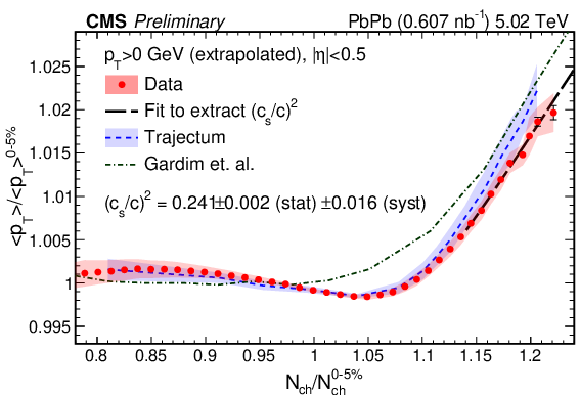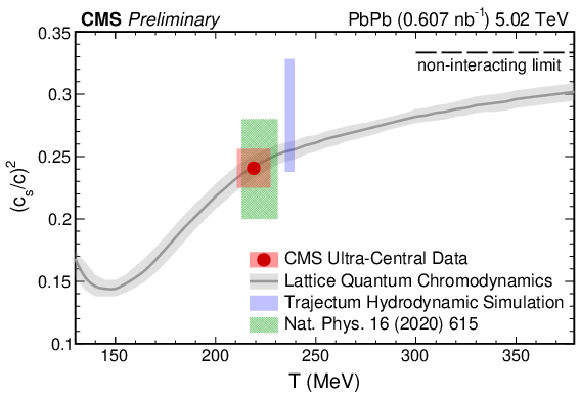

Compact Muon Solenoid
LHC, CERN
| CMS-PAS-HIN-23-003 | ||
| Extracting the speed of sound in the strongly interacting matter created in ultrarelativistic nuclear collisions | ||
| CMS Collaboration | ||
| 12 September 2023 | ||
| Abstract: Ultrarelativistic nuclear collisions yield a strongly interacting state of hot and dense quark-gluon matter that exhibits a remarkable collective flow behavior with minimal viscous dissipation. To gain deeper insights into its intrinsic nature, we extracted the speed of sound in this medium utilizing data from 0.607 nb$^{-1}$ of lead-lead collisions at $ \sqrt{\smash[b]{s_{_{\mathrm{NN}}}}}= $ 5.02 TeV, recorded by the CMS experiment in 2018 at the CERN-LHC. This is the most accurate measurement of this intrinsic characteristic to date and is performed using a new hydrodynamic probe in collisions with large overlap of the two lead nuclei. Our findings reveal that the squared speed of sound in this matter is 0.241 $ \pm $ 0.002 (stat) $ \pm$ 0.016 (syst) times the squared speed of light at an effective medium temperature of 219 $ \pm $ 8 (syst) MeV, precisely aligning with predictions from lattice quantum chromodynamic calculations. This result provides the most stringent and direct constraints on the deconfined QCD phase attained by the hot and dense matter created in these collisions. | ||
|
Links:
CDS record (PDF) ;
CADI line (restricted) ;
These preliminary results are superseded in this paper, Submitted to ROPP. The superseded preliminary plots can be found here. |
||
| Figures | |

png pdf |
Figure 1:
The normalized event count as a function of the charged particle multiplicity, $ N_{\mathrm{ch}} $, within the kinematic range of $ |\eta| < $ 0.5 and extrapolated to $ p_{\mathrm{T}}\approx $ 0 GeV, in PbPb collisions for most central events. The $ N_{\mathrm{ch}} $ is normalized by its value in the 0-5% centrality class. The curve represents the fit by the S. Das et. al. model in Ref. [29]. |

png pdf |
Figure 2:
The average transverse momentum of charged particles, $ \langle p_\mathrm{T} \rangle $, as a function of the charged particle multiplicity, $ N_{\mathrm{ch}} $, within the kinematic range of $ |\eta| < $ 0.5 and extrapolated to $ p_{\mathrm{T}}\approx $ 0 GeV. Both $ \langle p_\mathrm{T} \rangle $ and $ N_{\mathrm{ch}} $ are normalized by their values in the 0-5% centrality class. Bars and red bands correspond to statistical and systematic uncertainties, respectively. Hydrodynamic simulations from the Trajectum model [12] and model by Gardim et. al. [10] are also shown for comparison. The dash line is a fit to data by Eq. (1) in the range of $ N_{\mathrm{ch}}^{\mathrm{norm}} > $ 1.14. |

png pdf |
Figure 3:
The speed of sound, $ c^2_{\mathrm{s}} $, as a function of the effective temperature, $ T_{\mathrm{eff}} $, with one point extracted utilizing CMS ultra-central collisions PbPb data at $ \sqrt{\smash[b]{s_{_{\mathrm{NN}}}}}= $ 5.02 TeV. The size of the red box indicates systematic uncertainties of $ c^2_{\mathrm{s}} $ and $ T_{\mathrm{eff}} $. Values extracted from the Trajectum simulation [12] following the same fitting procedure as the data and from the earlier work [9] are presented as the other colored boxes. The curve shows the prediction from lattice quantum chromodynamics [1]. The dashed line at the value of 1/3 corresponds to the upper limit for non-interacting, massless (``ideal gas'') systems [30]. |
| Summary |
| In summary, this study presents a measurement of a new hydrodynamic probe for the most precise extraction to date of the speed of sound in ultrarelativistic heavy ion collisions. By leveraging the dependence of charged multiplicity on average particle transverse momentum in nearly head-on PbPb collisions, we determine the squared speed of sound to be 0.241 $ \pm $ 0.002 (stat) $ \pm $ 0.016 (syst) at an effective temperature of approximately 219 $ \pm $ 8 (syst) MeV. These findings demonstrate an excellent agreement with lattice quantum chromodynamic predictions, providing robust evidence for the existence of a deconfined phase of matter at extremely high temperatures. |
| References | ||||
| 1 | HotQCD Collaboration | Equation of state in ( 2+1 )-flavor QCD | PRD 90 (2014) 094503 | 1407.6387 |
| 2 | STAR Collaboration | Experimental and theoretical challenges in the search for the quark gluon plasma: The STAR collaboration's critical assessment of the evidence from RHIC collisions | Nucl. Phys. A 757 (2005) 102 | nucl-ex/0501009 |
| 3 | PHENIX Collaboration | Formation of dense partonic matter in relativistic nucleus-nucleus collisions at RHIC: Experimental evaluation by the PHENIX collaboration | Nucl. Phys. A 757 (2005) 184 | nucl-ex/0410003 |
| 4 | BRAHMS Collaboration | Quark gluon plasma and color glass condensate at RHIC? The perspective from the BRAHMS experiment | Nucl. Phys. A 757 (2005) 1 | nucl-ex/0410020 |
| 5 | PHOBOS Collaboration | The PHOBOS perspective on discoveries at RHIC | Nucl. Phys. A 757 (2005) 28 | nucl-ex/0410022 |
| 6 | U. Heinz and R. Snellings | Collective flow and viscosity in relativistic heavy-ion collisions | Ann. Rev. Nucl. Part. Sci. 63 (2013) 123 | 1301.2826 |
| 7 | J. Joseph et al. | Measurement of sound velocity in a Fermi gas near a Feshbach resonance | PRL 98 (2007) 170401 | |
| 8 | P. B. Patel et al. | Universal sound diffusion in a strongly interacting Fermi gas | Science 370 (2020) 1222 | 1909.02555 |
| 9 | F. G. Gardim, G. Giacalone, M. Luzum, and J.-Y. Ollitrault | Thermodynamics of hot strong-interaction matter from ultrarelativistic nuclear collisions | Nature Phys. 16 (2020) 615 | 1908.09728 |
| 10 | F. G. Gardim, G. Giacalone, and J.-Y. Ollitrault | The mean transverse momentum of ultracentral heavy-ion collisions: A new probe of hydrodynamics | PLB 809 (2020) 135749 | 1909.11609 |
| 11 | A. Sorensen, D. Oliinychenko, V. Koch, and L. McLerran | Speed of sound and baryon cumulants in heavy-ion collisions | PRL 127 (2021) 042303 | 2103.07365 |
| 12 | G. Nijs and W. van der Schee | Predictions and postdictions for relativistic lead and oxygen collisions with Trajectum | 2110.13153 | |
| 13 | CMS Collaboration | The CMS experiment at the CERN LHC | JINST 3 (2008) S08004 | |
| 14 | CMS Collaboration | Performance of the CMS Level-1 trigger in proton-proton collisions at $ \sqrt{s} = $ 13 TeV | JINST 15 (2020) P10017 | CMS-TRG-17-001 2006.10165 |
| 15 | CMS Collaboration | The CMS trigger system | JINST 12 (2017) P01020 | CMS-TRG-12-001 1609.02366 |
| 16 | CMS Collaboration | Electron and photon reconstruction and identification with the CMS experiment at the CERN LHC | JINST 16 (2021) P05014 | CMS-EGM-17-001 2012.06888 |
| 17 | CMS Collaboration | Performance of the CMS muon detector and muon reconstruction with proton-proton collisions at $ \sqrt{s}= $ 13 TeV | JINST 13 (2018) P06015 | CMS-MUO-16-001 1804.04528 |
| 18 | CMS Collaboration | Description and performance of track and primary-vertex reconstruction with the CMS tracker | JINST 9 (2014) P10009 | CMS-TRK-11-001 1405.6569 |
| 19 | CMS Collaboration | Particle-flow reconstruction and global event description with the CMS detector | JINST 12 (2017) P10003 | CMS-PRF-14-001 1706.04965 |
| 20 | G. Bayatian et al. | Design, performance and calibration of the CMS forward calorimeter wedges | EPJC 53 (2008) 139 | |
| 21 | O. Sur \'a nyi et al. | Performance of the CMS zero degree calorimeters in pPb collisions at the LHC | JINST 16 (2021) P05008 | 2102.06640 |
| 22 | CMS Collaboration | Charged-particle nuclear modification factors in PbPb and pPb collisions at $ \sqrt{\smash[b]{s_{_{\mathrm{NN}}}}}= $ 5.02 TeV | JHEP 04 (2017) 039 | CMS-HIN-15-015 1611.01664 |
| 23 | CMS Collaboration | Studies of azimuthal dihadron correlations in ultra-central PbPb collisions at $ \sqrt{\smash[b]{s_{_{\mathrm{NN}}}}} = $ 2.76 TeV | JHEP 02 (2014) 088 | CMS-HIN-12-011 1312.1845 |
| 24 | CMS Collaboration | Observation and studies of jet quenching in PbPb collisions at $ \sqrt{\smash[b]{s_{_{\mathrm{NN}}}}}= $ 2.76 TeV | Phys. Rev. C 84 (2011) 024906 | CMS-HIN-10-004 1102.1957 |
| 25 | CMS Collaboration | Mixed higher-order anisotropic flow and nonlinear response coefficients of charged particles in PbPb collisions at $ \sqrt{\smash [b]{s_{_{\mathrm {NN}}}}} = $ 2.76 and 5.02 TeV | EPJC 80 (2020) 534 | CMS-HIN-17-005 1910.08789 |
| 26 | GEANT4 Collaboration | GEANT4--a simulation toolkit | NIM A 506 (2003) 250 | |
| 27 | ALICE Collaboration | Centrality dependence of the charged-particle multiplicity density at midrapidity in Pb-Pb collisions at $\sqrt{\smash[b]{s_{_{\mathrm{NN}}}}} = $ 5.02 TeV | PRL 116 (2016) 222302 | 1512.06104 |
| 28 | ALICE Collaboration | Transverse momentum spectra and nuclear modification factors of charged particles in pp, p-Pb and Pb-Pb collisions at the LHC | JHEP 11 (2018) 013 | 1802.09145 |
| 29 | S. J. Das, G. Giacalone, P.-A. Monard, and J.-Y. Ollitrault | Relating centrality to impact parameter in nucleus-nucleus collisions | Phys. Rev. C 97 (2018) 014905 | 1708.00081 |
| 30 | S. Borsanyi et al. | The QCD equation of state with dynamical quarks | JHEP 11 (2010) 077 | 1007.2580 |

|
Compact Muon Solenoid LHC, CERN |

|

|

|

|

|

|